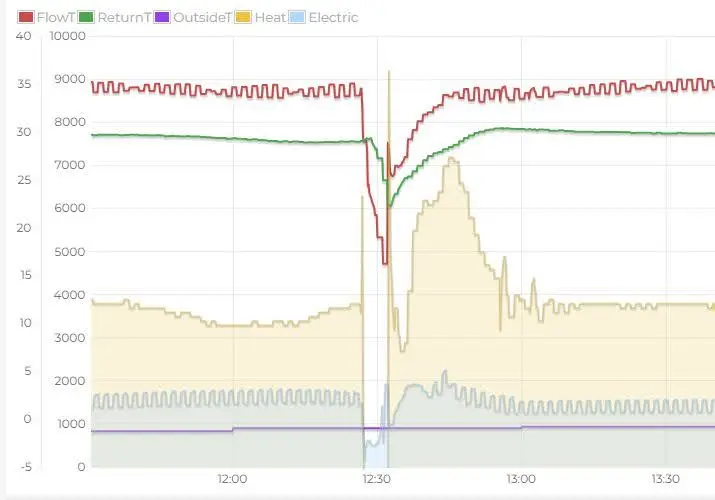Heat Pumps
Heat pumps are efficient heating and cooling systems that extract heat from the outside air, even in cold temperatures. However, as the temperature drops, moisture in the air can freeze on the outdoor unit's coils, reducing efficiency. To combat this, heat pumps have a built-in defrost cycle.
Yet, as winter sets in, more people are interested in just how and why their heat pumps are showing signs of defrosting. Certain weather conditions, such as freezing fog, create a defrost requirement for heat pumps. By understanding the reasons behind freezing, you can help ensure your heat pump operates efficiently throughout the winter.
Here, the Renewables team at City Plumbing offers a quick guide to heat pump defrosting, helping you learn more about what's happening inside these units.

Why Do Heat Pumps Freeze?
Sometimes when it’s people’s first winter owning a heat pump they can get quite worried, asking common questions such as “Why is my heat pump covered in ice, is everything ok?”, or “How do I stop my heat pump from defrosting?”
The good news is this usually isn’t anything to worry about. Heat pumps can become icy during cold snaps, but clearing it away is completely normal and a designed feature.
Why Freezing Occurs:
- Cold Temperatures: In cold weather, the temperature of the outdoor coils can drop below freezing.
- Ice Formation: The condensed moisture on the coils freezes, forming ice.
- Reduced Efficiency: Ice build-up on the coils can significantly reduce the heat pump's efficiency and ability to transfer heat.

How Do Heat Pumps Defrost?
Most modern heat pumps have a built-in defrost cycle that’s designed to prevent freezing.
Reversing Operation: The heat pump temporarily reverses its operation, using the indoor heat to melt the ice on the outdoor coils.
Hot Air Blowing: Hot air is blown over the coils to accelerate the melting process.
Normal Operation Resumes: Once the ice is melted, the heat pump returns to normal heating operation.
How the Defrost Cycle in a Heat Pump Works
In freezing conditions, a typical heat pump defrosts about every two and a half hours. This is a trace of heat output, electrical input, flow and return temps across an example defrost.
When the output starts to dip as the heat pump is very icy, it decides to defrost. At this point, it reverses the 4-way valve, slows down the compressor and starts sucking heat fairly gently out of the heating water. The flow temperature of the heat pump drops as low as 17.9°C here and the water on to the heat pump drops as low as 22.2°C.
By spending five minutes doing this, it successfully melts all the ice. Then the pump flips back to extracting heat from the air and runs up a bit faster to get the flow temperature back to 35°C.

Why Do Heat Pumps Have Defrost Systems?
Sometimes people worry about the heat they're losing to this process, but it's important to bear in mind that this is just borrowed energy being returned. Your heat pump has successfully extracted the latent heat of fusion of that water and heated your house with it, and it just has to pay it back now and again.
Is Frequent Defrosting Normal?
The frequency of defrost cycles depends on various factors, including:
- Outdoor Temperature: Colder temperatures lead to more frequent defrost cycles.
- Humidity Levels: Higher humidity increases the likelihood of frost formation.
- Heat Pump Age and Condition: Older or poorly maintained units may require more frequent defrost cycles.
However, if you do notice:
- Reduced Heating Capacity
- Increased Energy Consumption:
- Unusual Noises from the Outdoor Unit:
Then, it's advisable to consult a professional HVAC technician to diagnose and address any potential issues.
Additional Tips:
- Clear Debris: Regularly clear debris like leaves and snow from around the outdoor unit to ensure proper airflow.
- Proper Maintenance: Schedule regular maintenance checks to keep your heat pump running efficiently.
Does a Ground Source Heat Pump Have a Defrost Cycle?
No, ground source heat pumps typically do not have a defrost cycle.
Unlike air source heat pumps, which draw heat from the outside air, ground source heat pumps extract heat from the ground. The ground maintains a relatively stable temperature year-round, which means there's no risk of frost or ice forming on the heat exchanger coils.
This is one of the key advantages of ground source heat pumps as they can operate efficiently in colder climates without the need for frequent defrost cycles.

Trust City Plumbing For Your Renewable Energy Solutions
Ultimately, by understanding the defrost cycle and taking proactive measures, you can optimise your heat pump's performance and enjoy consistent warmth throughout the winter.
If you're looking for further information, help with your heat pump, or would like to make the move to renewable energy in your home or business, contact our Renewables Team at City Plumbing. Experts in the latest energy-efficient technologies, we're perfectly placed to help homes and businesses make the smooth transition to renewable technology.



